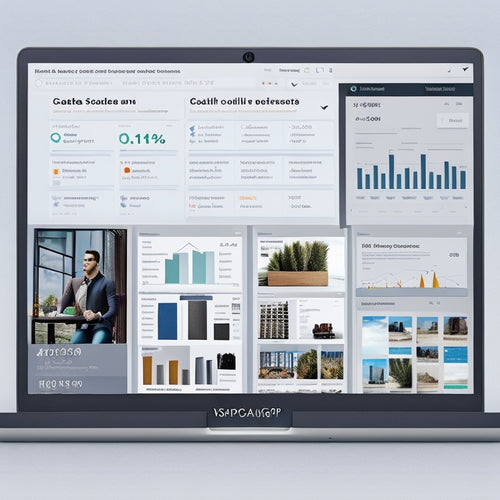
7 Best Online Course Strategies for Ecommerce Success
Share
You're on the path to ecommerce success, and online courses can be a game-changer. To drive sales, boost engagement, and build a loyal customer base, you'll want to master the 7 best online course strategies. Start by crafting compelling course content that resonates with your audience, then identify profitable niche topics that meet their needs. Structure engaging video lessons, build effective sales funnels, and develop persuasive email sequences that motivate action. Create valuable bonus materials, and launch successful affiliate partnerships. By implementing these strategies, you'll be well on your way to tapping into the $325 billion ecommerce online learning market. Now, dive deeper into the specifics that will set your course apart.
Key Takeaways
• Develop a deep understanding of the target audience to create a tailored online course that resonates with ecommerce entrepreneurs.
• Structure engaging video lessons around clear objectives, breaking down complex ideas into bite-sized chunks for easy comprehension.
• Craft persuasive email strategies that address audience pain points and motivations, using personalization and segmentation for higher conversions.
• Create valuable bonus materials that supplement core content, differentiating the course from competitors and increasing student engagement.
• Launch successful affiliate partnerships by offering competitive commission rates, streamlining payment processing, and tracking referrals accurately.
Crafting Compelling Course Content
To captivate your ecommerce students and drive engagement, you must craft course content that resonates with their needs, aspirations, and pain points, making it vital to develop a deep understanding of your target audience before creating your online course.
You can't just dump information; you need to create an immersive experience that draws students in and keeps them invested. That's where interactive elements come in. Incorporate quizzes, gamification, and discussions to break up the monotony of lectures and encourage student participation.
Storytelling techniques are also pivotal, as they help students connect emotionally with the material and remember it better. Use real-life examples, anecdotes, and case studies to illustrate key concepts and make them more relatable.
Identifying Profitable Niche Topics
To identify profitable niche topics for your online course, you'll need to conduct thorough market research.
You'll want to utilize niche market research tools to uncover hidden gems and identify trending products that have a high demand.
Niche Market Research Tools
By leveraging specialized market research tools, you'll be able to uncover profitable opportunities that resonate with your target audience and set your ecommerce business up for success. These tools help you identify hidden gems in the market, allowing you to create targeted content and products that meet the specific needs of your customers.
Here are some essential tools to add to your research arsenal:
-
Ahrefs: A thorough keyword analysis tool that helps you identify high-traffic keywords and topics, as well as analyze your competitors' strategies.
-
Google Trends: A free tool that provides insights into trending topics, allowing you to tap into current demand and create content that resonates with your audience.
-
Facebook Audience Insights: A powerful demographic targeting tool that helps you understand your target audience's interests, behaviors, and demographics, enabling you to create targeted ads and content.
Identifying Trending Products
You're on the hunt for products that are flying off virtual shelves, and identifying trending products is an essential step in ecommerce success, as it allows you to capitalize on current demand and stay ahead of the competition.
To do this, you need to conduct thorough product research, staying on top of market trends and consumer behavior. Analyze sales data, social media buzz, and customer reviews to identify patterns and opportunities. Look for products with a high demand, low competition, and a clear target audience.
You can use tools like Google Trends, Amazon Best Sellers, and eBay to find trending products. Additionally, keep an eye on emerging markets and seasonal demand to stay ahead of the curve.
Analyzing Competitor Gaps
Identifying profitable niche topics requires analyzing competitor gaps, where you pinpoint areas your competitors are neglecting or under-serving, and then capitalize on those opportunities to differentiate yourself and attract a dedicated customer base. This process involves conducting thorough gap analysis strategies and competitor research to identify market opportunities that others have overlooked.
Here are three key areas to focus on when analyzing competitor gaps:
-
Content gaps: Identify topics that your competitors aren't covering or are covering inadequately. This could be due to a lack of expertise or resources, or simply because they haven't considered the topic important. You can fill this gap by creating high-quality content that addresses the needs of your target audience.
-
Product gaps: Look for products or services that your competitors aren't offering or aren't offering effectively. This could be due to a lack of innovation or a failure to keep up with market trends. You can capitalize on this gap by offering unique products or services that meet the evolving needs of your customers.
-
Service gaps: Analyze the level of customer service provided by your competitors and identify areas for improvement. You can differentiate yourself by offering exceptional customer service that exceeds customer expectations.
Structuring Engaging Video Lessons
To engage your students' attention and convey intricate ecommerce concepts effectively, you'll need to deliberately structure your video lessons around clear learning objectives and enthusiastic storytelling techniques. This means breaking down complex ideas into bite-sized chunks, using relatable anecdotes, and incorporating interactive exercises that encourage students to apply what they've learned. You should also provide timely feedback to keep students motivated and on track.
To take your video lessons to the next level, focus on creating captivating visuals that complement your narrative. Use a mix of animations, graphics, and live-action footage to keep students engaged. Don't be afraid to get creative with your storytelling, using metaphors, analogies, and real-life examples to drive home key concepts.
Building Effective Sales Funnels
When building effective sales funnels, you'll want to start by mapping out the customer journey to identify key touchpoints that drive conversions.
By optimizing these conversion rates, you'll be able to maximize the return on investment for your online course.
To get started, let's break down the essential elements of funnel mapping and explore strategies for boosting conversions at each stage.
Funnel Mapping Essentials
You'll likely need to visualize your customer's journey to create an effective sales funnel, which is where funnel mapping comes in - an essential step in building a sales process that converts.
By mapping out your customer's journey, you'll be able to identify pain points, areas for optimization, and opportunities to nurture leads. This process allows you to create a tailored experience for your target audience, increasing the chances of conversion.
To get started with funnel mapping, consider the following key elements:
** Identify your target audience segments and their specific needs
** Determine the touchpoints and interactions that drive them towards a purchase
** Analyze the customer journey stages, from awareness to conversion, and identify areas for improvement
Optimize Conversion Rates
By pinpointing and addressing friction points in your sales funnel, you can greatly boost conversion rates and maximize revenue. To achieve this, you'll need to identify areas where potential customers are dropping off.
One effective way to do this is through A/B testing strategies, which allow you to experiment with different variables and measure their impact on conversion rates. Additionally, conducting customer feedback analysis can provide valuable insights into what's holding customers back from making a purchase.
Once you've identified the friction points, it's time to optimize your landing page. This is where social media advertising comes in – by driving targeted traffic to a well-designed landing page, you can increase conversions and reduce bounce rates.
Landing page optimization involves streamlining the user experience, ensuring that the page loads quickly, and making the call-to-action clear and prominent. By combining these strategies, you can create a seamless sales funnel that guides customers from awareness to purchase.
Developing Persuasive Email Sequences
Crafting a persuasive email sequence necessitates a profound understanding of your target audience's pain points, motivations, and buying habits. To develop an effective sequence, you need to know what propels your audience to make a purchase and what holds them back.
Once you have this insight, you can create targeted emails that resonate with your audience and drive conversions.
Here are some essential strategies to include in your email sequence:
-
Segment your email list: Divide your list into segments based on demographics, behavior, or preferences to guarantee the right message reaches the right person.
-
Use A/B testing: Test different subject lines, email copy, and call-to-action (CTA) buttons to observe what performs best and optimize your sequence accordingly.
-
Craft compelling copy: Employ copywriting techniques to write engaging email copy that addresses your audience's pain points and motivates them to take action.
Creating Valuable Bonus Materials
To take your ecommerce course to the next level, consider supplementing your core content with valuable bonus materials that provide additional insights, tools, or resources that address your students' specific needs and pain points. Bonus materials can be a game-changer in setting your course apart from the competition and increasing student engagement.
For instance, you can create bonus workbook ideas that provide actionable exercises and prompts to help students apply the concepts learned in the course. Another idea is creating interactive quizzes that test students' understanding of the material and provide personalized feedback.
Additionally, consider offering exclusive webinars that provide expert insights, Q&A sessions, or live coaching. You can also create downloadable templates that students can use to implement the strategies learned in the course. These bonus materials not only add value to your course but also demonstrate your commitment to your students' success.
Launching Successful Affiliate Partnerships
You're likely aware that affiliate partnerships can be a profitable way to scale your ecommerce course, but do you know how to identify and recruit the right affiliates who'll enthusiastically promote your product to their audiences? Effective affiliate recruitment is essential to the success of your partnership program.
Here are some key strategies to keep in mind:
-
Set competitive commission rates: Offer attractive commission rates to motivate your affiliates to promote your product.
-
Streamline payment processing: Make it easy for affiliates to receive their commissions by setting up a reliable payment processing system.
-
Track cookies and conversions: Use tracking cookies to monitor affiliate referrals and conversions, ensuring accurate commission payouts.
Frequently Asked Questions
Can I Create a Successful Online Course With Limited Technical Expertise?
You're worried that tech troubles will tank your online course dreams, but fear not! With simplified platforms and user-friendly tools, you can create a successful online course even with limited technical expertise, focusing on what matters most - sharing your expertise.
How Do I Balance Course Creation With Other Business Responsibilities?
You'll need to master time management and prioritization to balance course creation with other business responsibilities; consider outsourcing and delegating tasks to free up time and focus on high-leverage activities.
What if My Course Content Becomes Outdated Quickly?
"A million things can change overnight, but you can stay ahead by regularly scheduling content updates, leveraging technology to streamline processes, and prioritizing time management to keep up with market trends."
How Can I Ensure Students Complete the Entire Course?
To guarantee students complete your course, you'll want to implement engagement tactics that boost motivation, like interactive quizzes and rewards. Structure your course with clear progress tracking, so students can see their accomplishments and stay driven to reach the finish line.
What's the Ideal Course Length for Optimal Engagement and Retention?
You'll want to find the sweet spot for course length, balancing course pacing to hold student attention. Aim for 3-6 hours of video content, broken into 10-30 minute lessons, to keep students engaged and retain their interest.
Related Posts
-

How Do I Get Social Proof on Shopify
This article explores the concept of obtaining social proof on the Shopify platform. It highlights the benefits of i...
-

Analytics Shopify Apps Provide Merchants With Vital Insights Into Store Performance and Sales Metrics
This article examines the significance of analytics Shopify apps in providing merchants with essential insights into...
-

What Apps Are a Must for Shopify
This article aims to provide an informative overview of the essential apps for Shopify, a popular e-commerce platfor...


